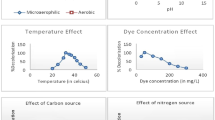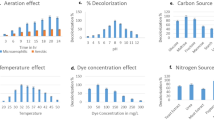Abstract
Textile industry is the major source of colored effluents constituting a number of complex dyes affecting terrestrial and aquatic ecosystems which necessitates their removal from environment. Bioremediation offers an inexpensive and eco-friendly approach hence, Pseudomonas sp. SUK 1, which is already known for its potential in degradation of individual dyes is used to degrade synthetic dye mixture of eight structurally different dyes. The bacterium was capable to remove 94.3 % American Dye Manufacturing Institute value of dyes mixture, within 24 h under static condition at pH 7 and 30 °C temperature. The results from the batch experiments revealed the ability of the tested bacterium to remove the synthetic dye mixture after repeated exposure. Induction in the activities of various biotransformation enzymes like laccase, veratryl alcohol oxidase, nicotinamide adenine dinucleotide-2, 6-dichlorophenol-indophenol reductase and tyrosinase was observed, indicating the significant role of these enzymes in biodegradation. After treatment significant decrease in chemical oxygen demand and biological oxygen demand was observed. The biotransformation of synthetic dye mixture was confirmed by UV–Vis spectroscopy, high performance liquid chromatography and Fourier transform infrared spectroscopy analyses of samples before and after decolorization. The toxicity analysis of degraded metabolites formed after biotransformation was carried out on Triticum aestivum, Phaseolus mungo and Sorghum vulgare crop plants with respect to germination ability, shoot and root length analysis. However oxidative stress study was carried out on Allium cepa L. proved that degraded metabolites were less toxic. Thus biodegradation of complex synthetic dye mixture to non-toxic metabolites using Pseudomonas sp. SUK 1 would be a better option for biological treatment of textile effluents.







Similar content being viewed by others
References
Slokar Y, Marechal M (1998) Methods of decolorization of textile wastewaters. Dyes Pigment 37:335–356
Munari F, Tamara A, Calloni G, Dillon A (2008) Decolorization of textile dyes by enzymatic extract and submerged cultures of Pleurotussajor-caju. World J Microb Biot 24:1383–1392
Katalay S, Parlak H (2004) The effects of pollution on haematological parameters of black goby (Gobiusniger L. 1758) in Foça and Aliağa bays. E U J Fish Aquat Sci 21:113–117
Calbiani F, Careri M, Elviri L, Mangia A, Pistara L, Zagnoni I (2004) Development and in-house validation of a liquid chromatography-electrospray-tandem mass spectrometry method for the simultaneous determination of Sudan I, Sudan II, Sudan III and Sudan IV in hot chilli products. J Chromatogr A 1042:123–130
Bhaskara M, Gnanamanib A, Ganeshjeevana RJ, Chandrasekara R, Sadullab S, Radhakrishnan G (2003) Analyses of carcinogenic aromatic amines released from harmful azo colorants by Streptomyces sp. SS07. J Chromatogr A 1018:117–123
Stiborova M, Martinek V, Rydlova H, Hodek P, Frei E (2002) Sudan I is a potential carcinogen for humans: evidence for its metabolic activation and detoxication by human recombinant cytochrome P450 1A1 and liver microsomes. Cancer Res 62:5678–5684
da Silva CG, Faria JL (2003) Photochemical and photocatalytic degradation of an azo dye in aqueous solution by UV irradiation. J Photochem Photobiol A 155:133–143
Okazaki S, Nagasawa S, Goto M, Furusaki S, Wariishi H, Tanaka H (2002) Decolorization of azo and anthraquinone dyes in hydrophobic organic media using microperoxidase-11 entrapped in reversed micelles. Biochem Eng J 12:237–241
Johnson RF, Zenhausen A, Zollinger H, Mark HF, Mcketta JJ, Othmer DF, Standen A (1978) Krik-Othmer encyclopedia of chemical technology, 2nd edn. Wiley, Hoboken, pp 868–910
Senan RC, Abraham TE (2004) Bioremediation of textile azo dyes by aerobic bacterial consortium. Biodegradation 15:275–280
Robinson T, McMullan G, Marchant R, Nigam P (2001) Remediation of dyes in textile effluent: a critical review on current treatment technologies with a proposed alternative. Bioresour Technol 77:247–255
Forgacs E, Cserhati T, Oros G (2004) Removal of synthetic dyes from wastewaters: a review. Environ Int 30:953–971
Bhattacharjee K, Banerjee S, Bawitlung L, Krishnappa D, Joshi S (2013) A study on parameters optimization for degradation of endosulfan by bacterial consortia isolated from contaminated soil. Proc Natl Acad Sci India Sect B Biol Sci. doi:10.1007/s40011-013-0223-5
Adedayo O, Javadpour S, Taylor C, Anderson WA, Moo-Young M (2004) Decolorization and detoxification of methyl red by aerobic bacteria from a wastewater treatment plant. World J Microb Biot 20:545–550
Kumar K, Devi SS, Krishnamurthi K, Dutta D, Chakrabarti T (2007) Decolorization and detoxification of direct blue-15 by a bacterial consortium. Bioresour Technol 98:3168–3171
Kumar K, Devi SS, Krishnamurthi K, Gampawar S, Mishra N, Pandya GH, Chakrabarti T (2006) Decolorization, biodegradation and detoxification of benzidine based azo dye. Bioresour Technol 97:407–413
Jadhav J, Govindwar S (2006) Biotransformation of malachite green by Saccharomyces cerevisiae MTCC 463. Yeast 23:315–323
Waghmode TR, Kurade MB, Govindwar SP (2011) Time dependent degradation of mixture of structurally different azo and non azo dyes by using Galactomycesgeotrichum MTCC 1360. Int Biodeter Biodegr 65(3):479–486
APHA (1998) Standard method for the examination of water and wastewater, 20th edn. American Public Health Association, Washington, DC
Jadhav SB, Yedurkar SM, Phugare SS, Jadhav JP (2012) Biodegradation studies on acid violet 19, a triphenylmethane dye, by Pseudomonas aeruginosa BCH. Clean 40:551–558
Kandaswami C, Vaidyanathan CS (1973) Oxidation of catechol in plants. IV. Purification and properties of the 3, 4, 3′, 4′ tetrahydroxydiphenyl forming enzyme system from Tecomaleaves. J Biol Chem 248:4035–4039
Tamboli DP, Kurade MB, Waghmode TR, Joshi SM, Govindwar SP (2010) Exploring the ability of Sphingobacteriumsp. ATM to degrade textile dye direct blue GLL, mixture of dyes and textile effluent and production of polyhydroxyhexadecanoic acid using waste biomass generated after dye degradation. J Hazard Mater 182:169–176
Jadhav SB, Phugare SS, Patil PS, Jadhav JP (2011) Biochemical degradation pathway of textile dye remazol red and subsequent toxicological evaluation by cytotoxicity, genotoxicity and oxidative stress studies. Int Biodeter Biodegr 65:733–743
Achary VM, Jena S, Panda KK, Panda BB (2008) Aluminium induced oxidative stress and DNA damage in root cells of Allium cepa L. Ecotoxicol Environ Saf 70:300–310
Chen K, Wu J, Liou D, Hwang S (2003) Decolorization of the textile dyes 454 by newly isolated bacterial strains. J Biotechnol 101:57–68
Kao C, Chou M, Fang W, Liu B, Huang B (2001) Regulating colored textile wastewater by 3/31 wavelength ADMI methods in Taiwan. Chemosphere 44:1055–1063
Verma P, Madamwar D (2003) Decolorization of synthetic dyes by a newly isolated strain of Serratia marcescens. World J Microb Biot 19:615–618
Kalme SD, Parshetti GK, Jadhav SU, Govindwar SP (2007) Biodegradation of benzidine based dye direct blue-6 by Pseudomonas desmolyticum NCIM 2112. Bioresour Technol 98:1405–1410
Paul J, Kadam AA, Govindwar SP, Kumar P, Varshney L (2013) An insight into the influence of low dose irradiation pretreatment on the microbial decolouration and degradation of reactive red-120 dye. Chemosphere 90:1348–1358
Mali PL, Mahajan MM, Patil DP, Kulkarni MV (2000) Biodecolorization of members of triphenylmethanes and azo groups of dyes. J Sci Ind Res 59:221–224
Kalyani DC, Patil PS, Jadhav JP, Govindwar SP (2008) Biodegradation of reactive textile dye red BLI by an isolated bacterium Pseudomonas sp. SUK 1. Bioresour Technol 99:4635–4641
Parshetti G, Kalme S, Saratale G, Govindwar S (2006) Biodegradation of malachite green by Kocuriarosea MTCC 1532. Acta Chim Slov 53:492–498
Dhanve RS, Shedbalkar UU, Jadhav JP (2008) Biodegradation of diazo reaction dye navy blue HE2R (reactive blue 172) by an isolated Exigubacteriumsp. RD3. Biotechnol Bioprocess Eng 13:53–60
Sanghi R, Dixit A, Guha S (2006) Sequential batch culture studies for the decolorization of reactive dye by Coriolus versicolor. Bioresour Technol 97:396–400
Moosvi S, Kcharia H, Madamwar D (2005) Decolorization of textile dye reactive violet 5 by a newly isolated bacterial consortium RVM 11.1. World J Microb Biot 21:667–672
Kadam AA, Lade HS, Patil SM, Govindwar SP (2013) Low cost CaCl2 pretreatment of sugarcane bagasse for enhancement of textile dyes adsorption and subsequent biodegradation of adsorbed dyes under solid state fermentation. Bioresour Technol 132:276–284
Shin KS (2004) The role of enzymes produced by white-rot fungus Irpexlacteusin the decolorization of the textile industry effluent. J Microbiol 42:37–41
Kalme SD, Parshetti GK, Jadhav SU, Govindwar SP (2006) Biodegradation of benzidine based dye direct blue 6 by Pseudomonas desmolytic NCIM 2112. Bioresour Technol 98:1405–1410
Ashraf M (2009) Biotechnological approach of improving plant salt tolerance using antioxidants as markers. Biotechnol Adv 27:84–93
Acknowledgments
First author would like to thank Department of Biotechnology and Bioinformatics, Padmashree Dr. D. Y. Patil University, Navi Mumbai and Department of Biotechnology, Shivaji University, Kolhapur for providing research facilities.
Conflict of interest
Authors declare that they have no conflict of interest.
Author information
Authors and Affiliations
Corresponding author
Rights and permissions
About this article
Cite this article
Chougule, A.S., Jadhav, S.B. & Jadhav, J.P. Microbial Degradation and Detoxification of Synthetic Dye Mixture by Pseudomonas sp. SUK 1. Proc. Natl. Acad. Sci., India, Sect. B Biol. Sci. 84, 1059–1068 (2014). https://doi.org/10.1007/s40011-014-0313-z
Received:
Revised:
Accepted:
Published:
Issue Date:
DOI: https://doi.org/10.1007/s40011-014-0313-z




